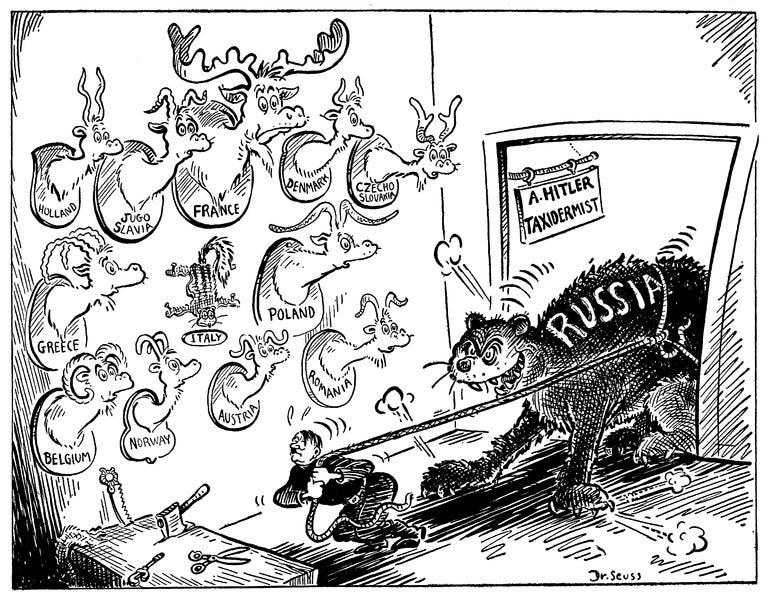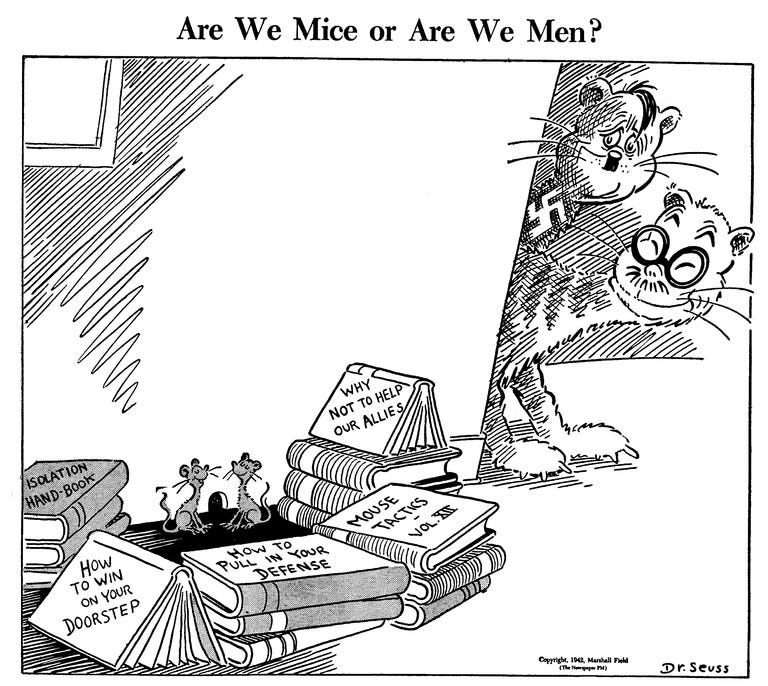Theodor Seuss Geisel -- Clark Kent to the Dr. Seuss superman -- wrote his first children's book in the 1930s. According to one report, twenty-seven publishers rejected And To Think I Saw it On Mulberry Street. By the time of his death in 1991, the good doctor had written forty-five children's books, and had worked with Warner Brothers animation legend Chuck Jones on the classic TV version of How the Grinch Stole Christmas.
The man’s spirit is resurrected every time a new generation of young readers is introduced to such duotone Trickster figures as The Grinch, The Cat in the Hat, and Sam I Am. He’s timeless.
Well, sort of. You may have heard the recent announcement that six of his titles will no longer be printed by Dr. Seuss Enterprises, which preserves the legacy of the late Geisel.
“These books portray people in ways that are hurtful and wrong,” the organization said in a release, of a decision reached after consulting teachers and experts.
"Ceasing sales of these books is only part of our commitment and our broader plan to ensure Dr Seuss Enterprises' catalogue represents and supports all communities and families," the statement added. The offensive imagery cited included an Asian drawn with a conical hat and slanted eyes, and Africans pictured in grass skirts.
The six titles - And to Think That I Saw It on Mulberry Street, If I Ran the Zoo, McElligot’s Pool, On Beyond Zebra!, Scrambled Eggs Super!, and The Cat’s Quizzer - immediately shot up in value on Amazon and other book-selling sites.
You may not know this: before he found worldwide acclaim as a children’s book author, Theodor Seuss Geisel was a wartime political cartoonist for the New York daily paper PM. The paper’s leaned heavily to New Deal Liberalism, as did Geisel’s cartoons. It was a war-friendly paper, which might sound unliberal to modern ears, until you remember the man who wrecked the brush mustache for everyone was also wrecking Europe at the time, killing great numbers of innocents - including his own people.
U.S. isolationism - with its strange bedfellows of conscientious objectors, pacifists and Nazi sympathizers - was a big bugaboo for Seuss. And for good reason: fascism was hardly a peripheral force within the US, as this video of a 1939 Nazi rally at Madison Square Gardens reveals (The Roosevelt administration narrowly avoided an attempted fascist coup just six years earlier - the “business plot” conspired upon by US banking interests and industrialists).
With the July 1941 invasion of Pearl Harbour, the US declared war on Japan, whose German ally then declared war on the US. The stacked turtles in this war production cartoon from March 20, 1942, anticipates Geisel’s later children’s book, Yertle the Turtle.
Here we see two American isolationist mice being regarded with interest by Hitler and the Japanese general, Tojo. Keep in mind the rendering of Tojo, it will come up again later.
Here’s famed aviator and Nazi sympathizer Charles Lindbergh patting a Swastika-patterned Fuhrer-serpent. Note that even Dr. Seuss’s most fearsome and reprehensible targets seem to end up looking rather whimsical.
Here’s Lindbergh again, dispensing anti-Semite sentiments…
In the buildup to the war across the Atlantic, it was unusual for political cartoonists of the time to endorse full participation of black workers in the labour force. Geisel did.
Try now to keep Geisel’s pro-labour, pro-black, pro-Jewish attitude in mind when you look at this:
This jaw-dropping rendering of West Coast Japanese-Americans as ant-like Tojos , collecting explosives and waiting upon orders from across the Pacific, isn’t just racist. It’s represents the mindset that led to interning Americans of Japanese descent as enemy agents for the remaining years of World War 2.
There’s no denying it: this is about as bad as it gets in terms of racial stereotyping in a political cartoon.
So here’s the problem. Is Geisel a hateful racist on days his cartoons about a supposed Japanese domestic threat appeared? And a broadminded, anti-racist campaigner for freedom on the other days? Or, like most human beings through history, is he a product of “good” and “bad” cultural programming, inherent to the culture of the time?
This underscores the difficulty of making a summary judgement on a creative genius’s moral worthiness, decades or more after the fact.
Like others, I get that pictures of Africans in grass dresses in children’s books are problematic. And though it’s not from a children’s book, those cartoons of Japanese Americans are right off the chart, as are some of his other wartime images of the Japanese enemy abroad.
But I also suspect that now a half dozen of Dr. Seuss children’s titles have been stricken from reprinting, critical eyes will be casting about the rest of his catalogue for any other offenses. Because, to alter the credo in Horton Here’s a Who, ‘an offense is an offense…no matter how small!’
Everything is fair game now. The Babar the Elephant books have been cancelled as “celebrations of colonialism” because the title character left the jungle and returned to “civilize” his friends. The Curious George books are also getting attention for comparable colonialist memes.
The ultimate irony is that Seuss was liberal progressive not just in his political cartoons (with a few unfortunate exceptions) but also in his children’s books (with a few unfortunate exceptions).
Liberal progressives! I’ve long considered myself one of them. However, that word now evokes the warriors of woke patrolling the social landscape for anything with the slightest whiff of racism, privilege, noninclusivity, transphobia, tokenism, heteronormativism, or any other form of discrimination, real or imagined. These moral fumigators - who believe free speech ends where feelings begin - now command the cultural high ground, from where they can vent all day long on their InstaTwitFacebullhorns (there, I just came up with a Seussism).
Surely our ancestors will never look back in dismay, thinking these censorious sorts started to get a tad totalitarian themselves. Nope. History is over, and it’s Year Zero everywhere, from kindergarten classrooms to Ivy League lecture halls.
Again, ironic considering this man should be regarded an ally. Examples of Seussian progressivism are found in The Sneeches, with its title creatures shunned because of the stars on their bellies (a reference to the Holocaust), or in Yertle the Turtle, in which the top terrapin is toppled by the fellows he’s clambered over for a higher position. With the Butter Battle Book, Seuss created a comical metaphor for the Cold War, and his last years he gave us his parable on unrestrained consumption in The Lorax - with a title character who sees his Truffula trees decimated for the Oncler’s making of heavily-consumed “Thneeds”. The author was master of what the animation trade calls “plums for moms” - references that kids likely won’t get, but adults might.
Seuss’s life lessons involved compassion, community, autonomy, nonjudgementalness, and living lightly on the Earth. I don't actually remember getting any explicit moral guidance from the Seuss books, and I don't imagine any of my young friends did either. These things are absorbed by osmosis, and percolate down to the subterranean levels where a young identity is formed. What I can say for sure is that there were a few times in adulthood when I called up Dr. Seuss’s spirit for the purposes of political satire.

There’s a kindness in Dr. Seuss’s artwork - the limpid, long-lashed eyes of the characters, the gentle crosshatched brushwork, and whimsically surreal backgrounds. His writing was of a piece with his art, and as a poet of high-spirited nonsense, he was in the league of Edward Lear or Ogden Nash. As kids, we didn’t read him for moral instruction but rather for the fun drawings and rhymes. He spoke our language: the silly singsong of innocence that preceded the serious nonsense of the grown-up world.
But that was my generation, a long time ago. Seuss’s heritage is now fraught with contending views. Geisel’s stepdaughter Lark Grey Dimond-Cates told The New York Post she believed pulling the six Seuss titles from circulation was a “wise decision.” But she had this to add: “There wasn’t a racist bone in that man’s body. He was so acutely aware of the world around him and cared so much."
More Seuss political cartoons viewable here.
Subscribe to Geoff Olson 2.0
Incandescent commentary and cartoons






















What a glowing tribute to someone who was a wonderful person but also a creature of his time, in some regards. What's next? Green eggs and ham offending Vegans?